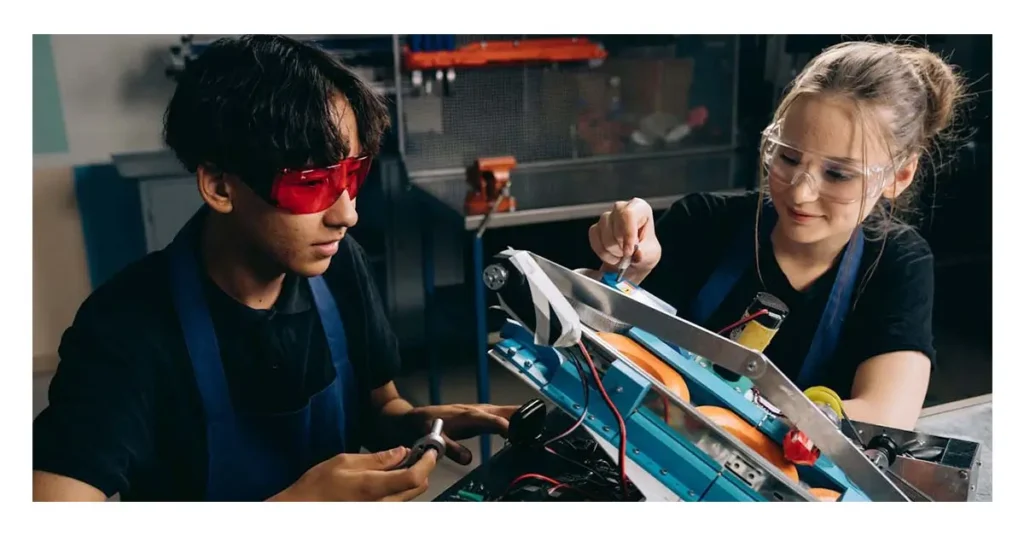Explore beyond basic safety glasses with our ultimate guide to diverse eye protection types! Discover how to safeguard your vision in any environment, from goggles and face shields to specialized gear for welding and sports. Stay safe, stay informed!
Thank you for reading this post, don't forget to subscribe!Eye protection is a crucial aspect of personal safety in various environments. Whether working in construction, conducting experiments in a laboratory, or engaging in recreational activities, safeguarding your eyes is paramount. In this comprehensive guide, we’ll explore the factors to consider when selecting the type of eye protection that best suits your needs.
Contents
Introduction to Eye Protection
Eye protection is crucial in various environments, from construction sites and laboratories to sports arenas and home workshops. While safety glasses are ordinary, many eye protection options are tailored to specific needs and hazards. In this comprehensive guide, we’ll delve beyond traditional safety glasses to explore the diverse world of eye protection types, their features, applications, and importance in safeguarding vision.
Before delving into the specifics, let’s understand the significance of eye protection. Our eyes are incredibly delicate organs, susceptible to injuries from hazards such as flying debris, chemicals, and harmful radiation. Eye injuries can lead to severe consequences, including vision loss or impairment. Therefore, wearing appropriate eye protection is essential to mitigate these risks.
Importance of Eye Protection
The eyes are vulnerable to a myriad of potential dangers in different settings. For instance, individuals working in construction are exposed to debris, dust, and blunt force trauma from tools and equipment. Chemical splashes or flying glass fragments in laboratories pose significant threats to eye safety. Even during recreational activities like sports, the risk of eye injuries from impact or UV exposure cannot be overlooked.

Types of Eye Protection
Understanding Eye Hazards:
Before delving into eye protection types, it’s essential to understand common eye hazards encountered in different settings. Types of hazards include impact, chemical splash, dust, radiation, and optical radiation from sources like welding arcs and lasers.
Each hazard requires specific protection to prevent injuries and maintain optimal eye health.
Safety Glasses:
- Traditional safety glasses are a fundamental form of eye protection.
- Made from durable materials like polycarbonate, they offer basic protection against impact and flying debris.
- They often feature wraparound designs to provide side protection and are available in various lens tints for lighting conditions.
- Suitable for general eye protection in industrial, construction, and laboratory environments. They provide basic protection against impacts and airborne particles.
Goggles:
- Goggles offer enhanced protection compared to safety glasses, sealing tightly around the eyes to prevent liquids, dust, and chemicals from entering.
- They come in different styles, including direct vent, indirect vent, and non-vented, and are suitable for various applications.
- Goggles are commonly used in laboratories, medical facilities, and industrial settings where chemical splashes and airborne particles are prevalent.
- Offer enhanced coverage and protection compared to safety glasses. Goggles form a seal around the eyes, guarding against chemical splashes, dust, and debris.
Face Shields:
- Face shields protect fully against impact, chemical splash, and heat hazards.
- They consist of a transparent visor mounted on a headgear made from polycarbonate or acetate.
- Face shields are crucial in industries such as welding, metalworking, and healthcare, where workers face significant risks to the face and eyes.
- It is ideal for situations requiring full-face protection, such as grinding, woodworking, or medical procedures. Face shields provide a barrier against larger projectiles and splashes.
Welding Helmets:
- Welding helmets are specialized eye protection devices designed for welding applications.
- They feature a shield with a darkened lens to protect against intense light and harmful ultraviolet (UV) and infrared (IR) radiation emitted during welding.
- Modern welding helmets often come with auto-darkening technology, providing a seamless transition between light and dark states and enhancing visibility and comfort for welders.
- Specifically designed for welding operations, these helmets shield the eyes from intense light, sparks, and infrared radiation produced during welding processes.
Laser Safety Eyewear:
- Laser safety eyewear is essential for protecting against the harmful effects of laser radiation.
- These glasses or goggles are constructed with specialized optical filters that block specific wavelengths of laser light.
- Laser safety eyewear is categorized based on the laser type and protection level, ensuring adequate shielding for users working with lasers in research, medical, and industrial settings.
Sports Eyewear:
- Sports eyewear protects athletes’ eyes from impact and UV radiation while enhancing performance and comfort.
- They feature impact-resistant lenses and durable frames to withstand rigorous activities.
- Sports-specific eyewear includes goggles for basketball, skiing, and swimming, offering tailored protection and visual clarity for each sport.
Prescription Safety Eyewear:
- Prescription safety eyewear combines vision correction with protective features, catering to individuals requiring corrective lenses in hazardous environments.
- They meet the same safety standards as regular protective eyewear while providing clear vision for wearers.
- Prescription safety glasses, goggles, and face shields have various lens options to accommodate different prescriptions and visual needs.
- Customized eyewear for individuals requiring vision correction. They combine the features of regular safety glasses with prescription lenses, ensuring clear vision and eye protection simultaneously.
Choosing the Right Eye Protection:
- Selecting appropriate eye protection involves assessing the specific hazards present in the environment.
- Consider factors such as impact resistance, chemical resistance, optical clarity, and comfort when choosing eye protection.
- Employers should conduct hazard assessments and provide suitable eye protection based on the identified risks, ensuring compliance with safety regulations and standards.
Maintenance and Care:
- Proper maintenance and care are essential to prolong the lifespan and effectiveness of eye protection.
- Regularly inspect eyewear for damage, scratches, or signs of wear and tear.
- Clean eyewear with mild soap and water or specialized lens cleaning solutions to remove dirt, debris, and chemical residues without compromising optical clarity.
Factors to Consider When Choosing Eye Protection
When selecting eye protection, several factors should influence your decision:
-
Nature of Work or Activity
Assess the specific hazards present in your work environment or activity. Consider the type and severity of potential eye injuries to determine the level of protection required.
-
Level of Protection Needed
Choose eye protection that meets or exceeds the safety standards relevant to your industry or activity. Look for products with appropriate impact resistance, optical clarity, and coverage.
-
Comfort and Fit
Opt for eyewear that feels comfortable and fits securely. Ill-fitting eye protection can cause discomfort and may compromise safety by slipping or becoming dislodged during use.
-
Durability and Material
Select durable eye protection made from high-quality materials that can withstand the demands of your work environment. Consider factors such as scratch resistance, anti-fog coatings, and UV protection.
-
Cost
While cost is a consideration, prioritize quality and safety over price alone. Investing in premium eye protection can prevent costly medical expenses from eye injuries.
-
Compliance with Safety Standards
Ensure the eye protection you choose complies with relevant safety regulations and standards. Look for products certified by recognized organizations like ANSI (American National Standards Institute) or OSHA (Occupational Safety and Health Administration).
Special Considerations for Specific Activities
Different activities may require specialized eye protection:
- Construction and Industrial Work: Opt for robust safety glasses or goggles with side shields to protect against impact, dust, and debris.
- Laboratory Work: Choose goggles or face shields with chemical-resistant materials to safeguard against splashes and spills.
- Sports and Recreational Activities: Select sports goggles or sunglasses with impact-resistant lenses and UV protection for outdoor activities.
Common Mistakes to Avoid When Choosing Eye Protection
- Neglecting to Assess Risks: Failure to identify potential hazards can lead to inadequate eye protection.
- Ignoring Proper Fit: Ill-fitting eyewear compromises comfort and safety.
- Using Improper Eyewear for the Task: Each activity requires specific eye protection tailored to its unique hazards.
Tips for Proper Maintenance and Care of Eye Protection
- Regular Inspection: Check eye protection for any signs of damage or wear.
- Cleaning: Clean eyewear regularly with mild soap and water to maintain visibility.
- Storage: Store eye protection in a clean, dry place away from direct sunlight or extreme temperatures.
FAQs
Q. What are the key differences between safety glasses and goggles?
Safety glasses provide basic protection against impact and debris, while goggles offer enhanced coverage. They seal tightly around the eyes to prevent liquids, dust, and chemicals from entering.
Q. How do I choose the proper eye protection for welding applications?
Opt for specialized welding helmets with darkened lenses to protect against intense light and harmful radiation for welding. Look for features like auto-darkening technology for seamless transitions and optimal visibility.
Q. Can I use regular sports sunglasses as eye protection during sports activities?
Regular sports sunglasses may provide UV protection but lack the impact resistance required for safety during sports. Wear sports-specific eyewear with impact-resistant lenses and durable frames designed for rigorous activities.
Q. What should I consider when selecting prescription safety eyewear?
When choosing prescription safety eyewear, consider impact resistance, chemical resistance, and optical clarity. Ensure the eyewear meets safety standards and provides adequate protection while correcting vision.
Conclusion
Eye protection is critical to workplace safety and personal well-being, preventing injuries and preserving vision in various environments. Beyond traditional safety glasses, various eye protection types address specific hazards and requirements. By understanding the features, applications, and importance of different eye protection options, individuals and organizations can make informed decisions to ensure optimal eye safety and health.
Proper eye protection is crucial for safeguarding your vision and preventing potential injuries. You can ensure optimal eye safety in any environment by considering the nature of your work, the level of protection needed, comfort, and compliance with safety standards.
Read more articles on Health and Wellness.
You might like to read:
The Power Behind Evil Eye: Beliefs, Superstition and Protection



